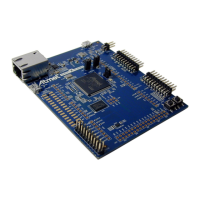3. Xplained Pro
Xplained Pro is an evaluation platform that provides the full Atmel microcontroller experience. The
platform consists of a series of Microcontroller (MCU) boards and extension boards, which are integrated
with Atmel Studio, have Atmel Software Framework (ASF) drivers and demo code, support data
streaming, and more. Xplained Pro MCU boards support a wide range of Xplained Pro extension boards,
which are connected through a set of standardized headers and connectors. Each extension board has
an identification (ID) chip to uniquely identify which boards are connected to an Xplained Pro MCU board.
This information is used to present relevant user guides, application notes, datasheets, and example
code through Atmel Studio.
3.1. Embedded Debugger
The SAME70-XPLD contains the Atmel Embedded Debugger (EDBG) for on-board debugging. The
EDBG is a composite USB device of three interfaces: a debugger, Virtual COM Port, and a Data Gateway
Interface (DGI).
Together with Atmel Studio, the EDBG can program and debug the ATSAME70Q21. On the SAME70-
XPLD, the SWD interface is connected between the EDBG and the ATSAME70Q21.
The Virtual COM Port is connected to a UART on the ATSAME70Q21 and provides an easy way to
communicate with the target application through terminal software. It offers variable baud rate, parity, and
stop bit settings. Note that the settings on the ATSAME70Q21 must match the settings applied in the
terminal software.
Note: If not set automatically, data terminal ready (DTR) must be set in the terminal software.
The DGI consists of several physical interfaces for communication with the host computer.
Communication over the interfaces are bidirectional. It can be used to send events and values from the
ATSAME70Q21 or as a generic printf-style data channel. Traffic over the interfaces can be timestamped
on the EDBG for more accurate tracing of events. Note that timestamping imposes an overhead that
reduces maximal throughput. Atmel Data Visualizer is used to send and receive data through DGI.
For further documentation on the EDBG, see the EDBG User Guide.
3.2. Hardware Identification System
All Xplained Pro compatible extension boards have an Atmel ATSHA204 CryptoAuthentication
™
chip
mounted. This chip contains information that identifies the extension with its name and some extra data.
When an Xplained Pro extension is connected to an Xplained Pro MCU board the information is read and
sent to Atmel Studio. The Atmel Kits extension, installed with Atmel Studio, will give relevant information,
code examples, and links to relevant documents. The table below shows the data fields stored in the ID
chip with example content.
Table 3-1 Xplained Pro ID Chip Content
Data field Data type Example content
Manufacturer ASCII string Atmel'\0'
Product Name ASCII string Segment LCD1 Xplained Pro'\0'
Product Revision ASCII string 02'\0'
Product Serial Number ASCII string 1774020200000010’\0’
Atmel SAME70-XPLD [USER GUIDE]
Atmel-44050A-SAME70-XPLD_User Guide-12/2015
7

